The clocks have gone back, the nights are drawing in, and it’s time to share my grayling flies for November because…
“Our grayling friends are busy feasting so they’re in peak condition to spawn in spring”
As the temperatures begin to fall during November, fly hatches become sparse on the Welsh Dee, and grayling are increasingly searching the riverbed for food: nymphs, larvae, worms etc.
However, when the river is running cleat on mild November days (ca. 10+oC), you might be lucky to see a hatch of any of the following flies…
Upwing Flies
- Large Dark Olive
- Sherry Spinner
- Iron Blue (mild days)
Sedges & Others
So, it’s time to reveal how I arrived at my…
“Go-To” grayling flies for November on the Welsh Dee
Grayling flies for November:
November is the last month of Autumn, but the weather on the Welsh Dee can range from a mild 17oC to a wintery sub-zero (reference – for mid-November in Llangollen, the long-term historical average high & low temperatures are 9oC & 5oC, respectively).
This dichotomy of weather conditions shows up strongly in my fishing log, which influences fly choice and fishing technique during November.
In addition to temperature, there were three other variables to consider when deciding on the best approach:
- River level
- Water clarity
- Quantity of fallen leaves in the river
However, after analysing my fishing log data in several ways, the river level was the most important variable.
Therefore, I’ve split my November fly recommendation into four subgroupings based on:
“Temperature and River Level”
A) Grayling flies for November on mild days when the river level is below 0.6m
On mild days (ca. > 10oC), when the Welsh Dee is between 0.4 & 0.6m (Manley Hall gauge), graylings are likely to be seen taking flies at the surface.
Under such conditions, you can have a…
grayling bonanza fishing dry flies & wet flies.
The flies that often work well include:
Grayling dry fly selection:

Elk hair caddis (cream tag)
- Hook: Kamasan B170 #12
- Thread: Burnt orange UNI 8/0
- Tail: Cream Anton yarn
- Body: Fox Squirrel dubbing
- Rib: Gold wire
- Wing: Natural Elk hair
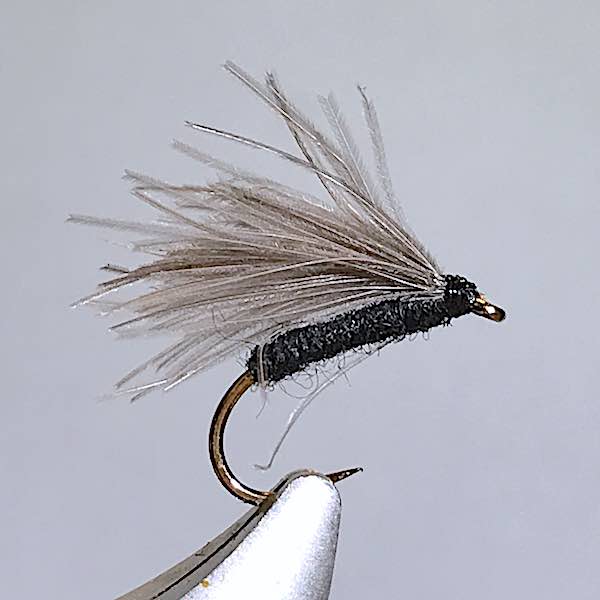
F-fly in various colours
- Hook: Kamasan B170 #16 & 18
- Thread: Black UNI 8/0
- Body: fine dubbing (black, olive etc)
- Wing: 3 CDC feathers
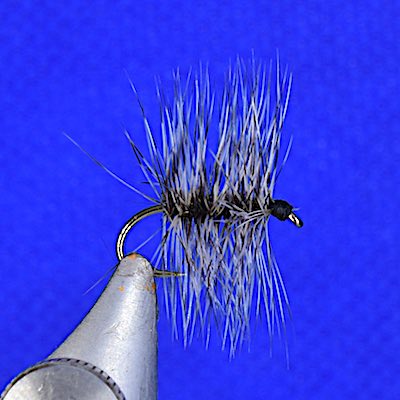
Griffith Gnat
- Hook: Kamasan B170 #18
- Thread: Black UNI 8/0
- Body: Peacock herl
- Hackle: palmered Grizzle cock
Grayling wet Fly selection:
In November, my default recommendation would be to start with a three-fly cast on a 3lb copolymer leader (point: size 14, black hopper; middle dropper: size 14 PR – March Brown spider; top dropper: size 16, Treacle Parkin).
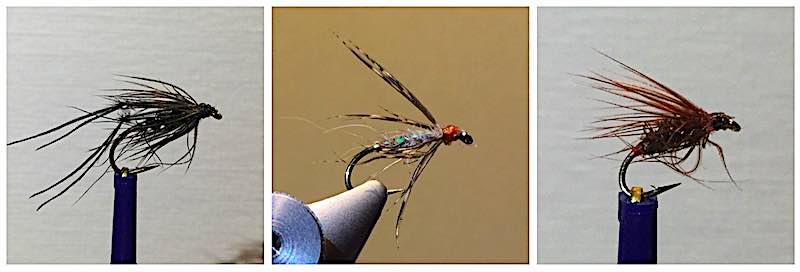
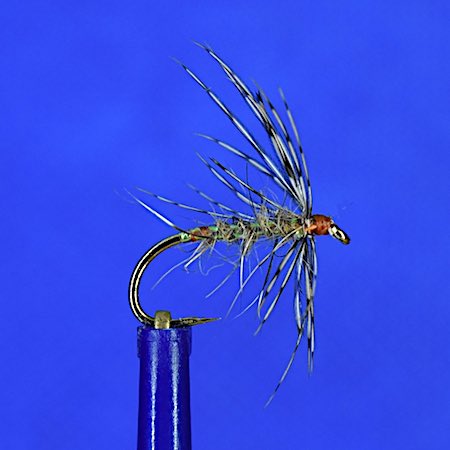
Pearl-ribbed March Brown Spider
- Hook: Kamasan B170 #14
- Body: Tan UNI-Thread 8/0
- Rib: Pearl Mylar #14 (1/32)
- Hackle: Brown partridge neck
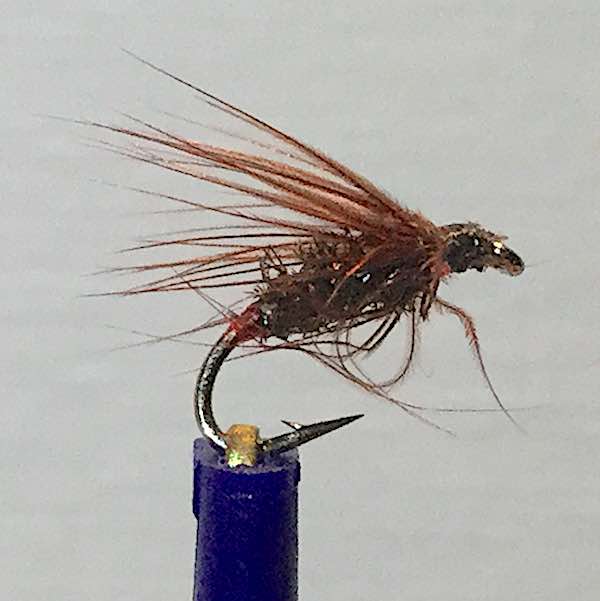
Treacle Parkin (red-tag)
- Hook: Kamasan B170 #16
- Body: Brown UNI-Thread 8/0
- Tag: Red UNI-Thread 8/0
- Body: Peacock herl
- Hackle: Brown hen

Black Hopper
- Hook: Kamasan B170 #14
- Thread: Black UNI-Thread 8/0
- Body: Black Seals fur substitute
- Rib: Pearl Mylar #14 (1/32)
- Legs: Black pheasant tail
- Hackle: Black Hen
Where best to fish the wet flies?
When the Welsh Dee is close to its summer level (<0.5m Manley Hall gauge), I focus my fishing in the following areas:
- the fast water leading into the pool
- alongside weed beds, large rocks, ledges, and snags
- the glide leading into the tail of the pool
Check out my wet fly fishing page for more information on how I fish wet flies.
B) Grayling flies for November on cold days when the river level is below 0.6m
On cold days (ca. < 7oC) when the Welsh Dee is between 0.4 & 0.6m (Manley Hall gauge) grayling will be feeding close to the riverbed. Under such conditions, Czech (euro) nymphing usually outfishes the other methods.
The flies that work well include:
Selection of Grayling nymphs

Pheasant tail nymph (orange tag)
- Hook: Hends BL154 (#14 & 12)
- Bead: 2.5mm tungsten (silver & gold)
- Thread: Brown UNI-Thread 8/0
- Tail: 3 pheasant tail fibre
- Body: pheasant tail fibres
- Rib: Fine copper wire
- Thorax: Olive dubbing
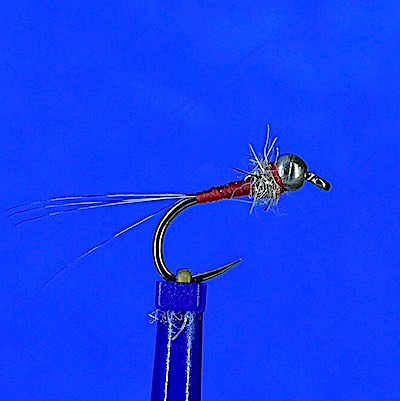
Red nymph
- Hook: Hends BL 354 (#18 & 16)
- Bead: 1.5mm tungsten
- Thread: waxed red UNI-Thread 8/0
- Tail: Coq De Leon fibres
- Body: red UNI-Thread 8/0
- Thorax: Fox squirrel dubbing
- Wing case: Pearl Mylar 1/8”
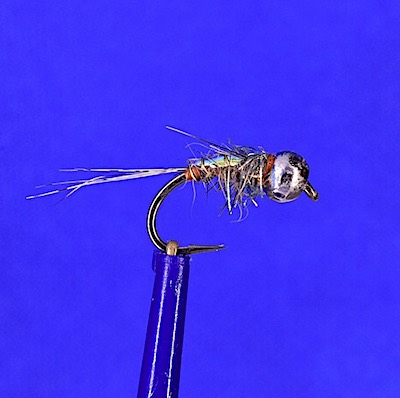
Hare Ear shell-back nymph
- Hook: Kamasan B100 #14 & 16
- Bead: 2 – 3mm tungsten (pink, gold)
- Thread: 8/0 rusty orange
- Body: Hare Ear
- Back: Mylar tinsel
- Rib: Gold wire
A November grayling caught in Duncan’s pool on the Hare’s Ear shell-back:
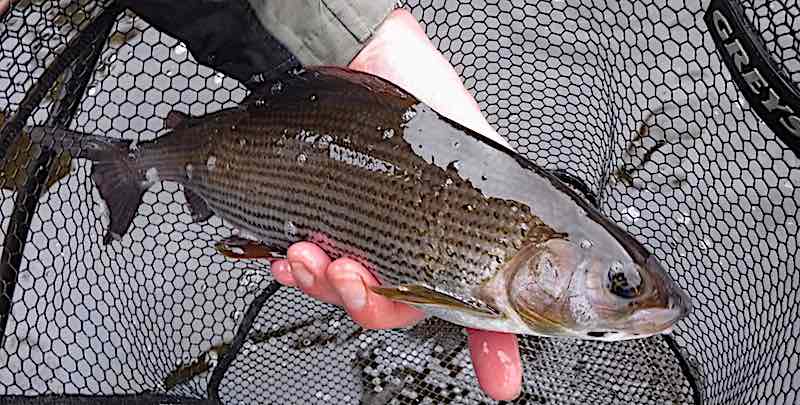
C) Grayling flies for November on mild days when the river level is above 0.6m
On mild days (ca. > 11oC), when the Welsh Dee is between 0.6m to 1m (Manley Hall gauge), there is a chance that grayling are taking flies at the surface in the slower sections of the pools. Under such conditions, it is worth trying one of the dry or wet flies covered in section A above.
Otherwise, Czech (Euro) nymphing usually produces the best results. Czech nymphing is not everyone’s cup of tea, but when grayling are feeding on the riverbed, it’s the best way to catch them.
If the river is running clear, then I would typically use heavier versions of the Czech nymphs mentioned in section B.
When the Welsh Dee is carrying colour after a spate, it is necessary to fish large, heavy nymphs to reach grayling feeding close to the riverbed.
There are many patterns that work on the Welsh Dee – see Czech nymphing page. However, I’ve had many fishing trips where the only way to catch grayling is to use a squirmy worm.
Not my favourite fly, but it is worth having a few in your box because they will help you avoid a blank day
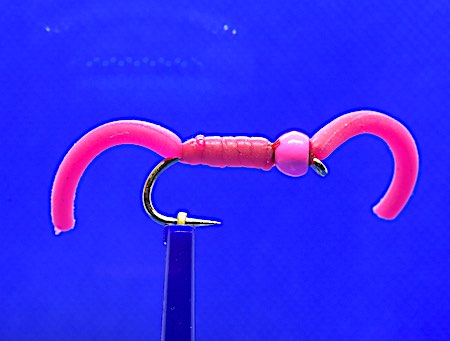
Pink Squirmy Worm
- Hook: Kamasan B100 #14 & 12
- Bead: 3.5 mm tungsten
- Thread: red UNI-Thread 8/0
- Body: Pink squirmy
Fishing the Dee Farm Pool in high water (1.1m) with a pink squirmy worm produced this lovely Welsh Dee grayling.

D) Grayling flies for November on cold days when the river level is above 0.6m
Cold days (ca. < 7oC), when the Welsh Dee is between 0.6m to 1m (Manley Hall gauge), are difficult fishing conditions. However, you can still catch a few grayling by opting for Czech (euro) nymphing.
Usually, I fish the slacker sections of the pool with a team of Czech nymphs with a size 12 XL tungsten jig-back on the point and sometimes on the middle dropper. This heavy point fly ensures the other nymphs are fishing close to the riverbed (i.e. those mentioned in section B).
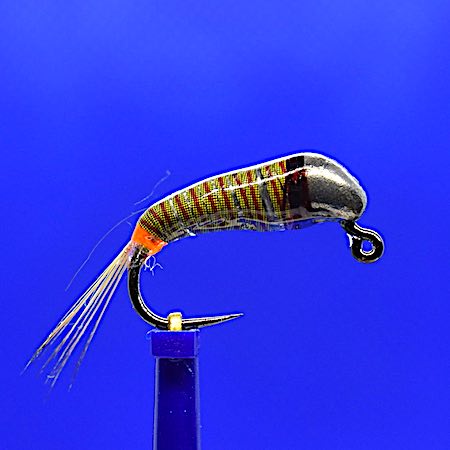
Olive Tungsten Jig-back
- Hook: Hends BL124 (#12)
- Weight: XL-tungsten jig-back
- Thread: Claret UNI-Thread 8/0
- Tail: badger cock hackle fibres
- Tag – orange UNI-Thread 8/0
- Body: Olive synthetic quill
- Coating: UV – Varnish:
I used the above tungsten jig-back nymph on the point to drag a # 18 red nymph down to the river bed, which caught this lovely Welsh Dee grayling.
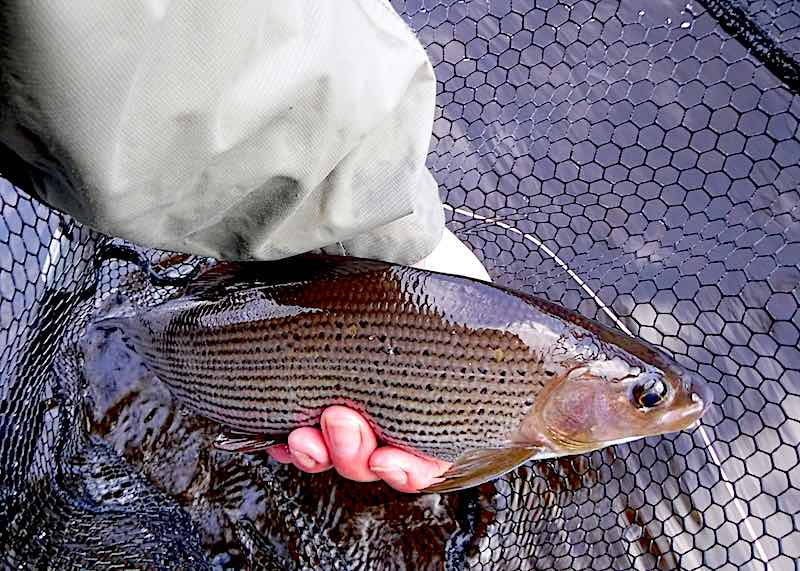
The fly above advice is based on my records that, over many years, have reliably caught grayling, making them a great starting point for a newcomer fishing the Welsh Dee.
Further reading
For more information on fly fishing for grayling on the Welsh Dee during autumn check out the following post:
- Grayling fly fishing in Autumn with a focus on the beautiful Welsh Dee
- Grayling fishing in November on the Welsh Dee & River Eden
Also if you are interested in fly fishing on the Welsh Dee there is some excellent Day Ticket water at Llangollen.
PS. It would be great to hear what your favourite grayling flies for November are.

Have you thought of publishing your work ? Very informative & I’d happily buy
Hi Bryan,
Thanks for your great feedback. The aim of the website and blog is to help others start or improve their fishing and because it’s it removes the cost barrier.
Cheers, Andrew
Excellent as ever Andrew. Your experience definitely takes a lot of the guesswork out of how/when to fish the Dee.
Hi Nigel,
Great to hear that you have enjoyed the post.
Cheers, Andrew
Morning Andrew, i have been fishing the fisheries for years and now im in my 60’s am fed up on the same old same old so going to join my local river fishing ath ADAA up here in aberdeen, as you prob know we have our own river DEE and the Don both mouth out only a few miles apart from the sea at Aberdeen city so other than rod and reel am starting a fresh so to speak, so just wanted to say its been great and very informative reading your blogs, i know all rivers are different, but its the try of fly and at what time of year to use them things like that help newbies on the river like me no end.
of course season on our rivers ends today 31/10 so will have all winter to get prepared so the more i read the better, o and i might be interested in buying some of your flies as others have said.
thxs for the great blogs
regards john mckenzie
Hi John,
It great to hear you have been enjoying my blog posts. I’ve never fished the Dee or Don in Scotland but I would suspect that the flies will work there too.
We’ve gone into lockdown now until December so will be doing more writing about fishing than actual fishing for the next month. Just hoping I can get out grayling fishing before Xmas.
Cheers, Andrew
Excellent article Andrew, particularly liked the advice on river levels and temperature. Thanks!
Hi Ron,
Glad you enjoyed it and thanks for the feedback.
Cheers, Andrew
do you ever do long trotting with a centre pin reel
Hi Emrys,
A long time ago I did and it was good fun but now just focus on fly fishing.
Andrew
These should be good on the Annan. Grayling day 20th November. Just got into Grayling fishing last year, can’t wait.
Hi Steve,
Would be great to know how you get on with them.
Tight lines, Andrew
Hi Andrew, thanks from such a comprehensive and informative website, I am heading to the Welsh Dee on Friday for my first ever visit, having read all of your excellent guidelines,I’m busy tying up fly’s to fill the gaps in fly box really looking forward to my day.
Hi Dave,
Great to hear you are finding the blogs helpful and interesting. The Welsh Dee is very high at the moment but with a bit of luck and some dry weather, it might be Ok by Friday.
Tight lines, Andrew
Fantastic reading again.
I’ve ordered a selection of nymphs as close as I could get to those mentioned in above article so fingers crossed and let’s see what the lady of the stream brings.thanks andrew
Hi Andy,
Great to hear you enjoyed it and I hope the flies help you catch some good grayling.
Cheers, Andrew